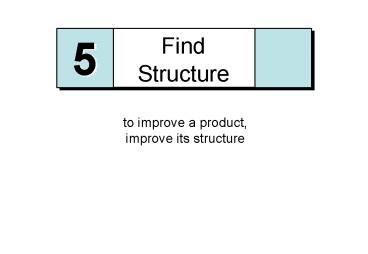Structure - PowerPoint PPT Presentation
1 / 24
Title:
Structure
Description:
Surfactant Stabilization. 0.4 nm. head. tail. 0.2 nm. 2 nm. likes water. hates water. cationic surfactant: film in foam: thin spot. higher g. opposes thinning. 1 ... – PowerPoint PPT presentation
Number of Views:37
Avg rating:3.0/5.0
Title: Structure
1
Structure
5
Find Structure
to improve a product, improve its structure
2
Model with Parts
It is not possible to describe a structure
completely
rough description with a limited number of parts
these have
a size
micro- or nano-range
spheres, cylinders, films
a shape
an ordering
a geometrical model helps in understanding
a volume
interfaces
3
Shaving Foam
2 mm
Intel Play QX3 microscope
lighting from above
enhanced in PhotoPaint
liquid continuous
gas dispersed
4
Density and Volumes
density with a letter balance
160 mL
12 g foam
volumes
fractions
questions
why this density?
influence on shaving?
influence on price?
why this bubble size?
are these independent?
5
Surfactant Stabilization
cationic surfactant
film in foam
head
0.4 nm
likes water
2 nm
tail
thin spot
1
higher g
hates water
opposes thinning
0.2 nm
head charges repel
2
opposes thinning
6
Interfaces
properties of fine structures depend on the
interface properties
air
air
wetting
adsorption
water
water
10 nm
1 nm
cotton
fat
minor components gather on interfaces and
determine properties
7
Bubble Model
spherical bubbles, equal diameter
model
what does this tell about the interface?
for a single bubble
per m3 of foam
what does this tell about the film thickness?
liquid per m3 of foam
average thickness
could these values be of any use in development?
8
Sponge
2 mm
small piece from the top
Intel Play QX3 microscope
lighting from above
bi-continuous structure
9
Density and Volumes
density with a letter balance
160 mL
8 g foam
yellow part
volumes
fractions
questions
what happens with much smaller / larger cells?
what happens with a stiffer / softer sponge?
how could we make it stiffer or softer?
10
Open Cell Model
open cubic cells, length
model
to find volume fractions and interface, look at a
single cell
struts
interface
could this be of any use in development?
11
Forming an Open Structure
films must break
1
possible mechanism
2
solvent vapour lowers g and h
film pulled to side
film breaks
12
Textile
0.7 mm
white cotton handkerchief
(one layer)
Intel Play QX3 microscope
lighting from below
two scales in the solid
yarns
fibres
bi-continuous structure
13
Yarn and Fibre Model
cylindrical yarns dY 0.25 mm
model
cylindrical fibres dF 0.01 mm
fibres 10 mm
yarns
air between yarns
0.25 mm
air between fibres
no stabilization
14
Density and Volumes
total volume handkerchief
eS 0.17
e''G 0.08
volume of cotton (fibres)
mcotton 14 g
air in yarns
e'G 0.75
air between yarns
interface
15
Tissue
2 mm
torn edge of piece of tissue
Intel Play QX3 microscope
lighting from below
bi-continuous structure
16
Making Tissue
slurry of fibres flows on to band
1
'mat' dries and binds
3
'mat' dewaters
2
moving porous band
17
Cylindrical Fibre Model
cylindrical fibres dF 0.01 mm
model
randomly spaced
void fractions from density
interface
spacing is not really random (see text)
where could this help ?
18
Toothpaste
0.7 mm
toothpaste thinned with water
Intel Play QX3 microscope
lighting from below
particles hydrated silica
humectant propylene glycol
flocculant cellulose gum
19
Touching Particles Model
spherical particles d 0.02 mm
model
touching to give a weak solid
water
solubles
propylene glycol humectant
cellulose gum flocculant
particles
hydrated silica
normally too little to get a solid
20
Depletion Flocculation
polymer coils cannot enter contact region
higher Cwater
water pulled out
lower pressure
( -10 MPa!)
21
Ice Cream
0.2 mm
volume fraction
air
0.50
ice
0.40
water
0.05
sugars
casein
0.04
fat globules
0.10
gelatin matrix
0.01
variable!
0.01
surfactant
22
Sizes of Parts
microscope
grain of sand
virus
1
7
water molecule
thickness of hair
2
8
wave length of light
drop in mayonnaise
3
9
protein
bacterium
4
10
bubble (shaving foam)
human cell
5
11
pigment in paint
soap micelle
6
12
23
Summary
structure properties ? component properties
can be very different
parts of structures have
a size
micro- or nano-range
spheres, cylinders, films
a shape
continuous, dispersed, coating
an ordering
important attributes are
volume occupied by parts
interface of parts
many structures have to be stabilised
24
Sizes of Parts
6
1
2
3
4
5
7
8
9
10
12
sand
light
11
virus
bubble
micelle
pigment
protein
molecule
hair
bacterium
drop in mayonnaise
human cell































